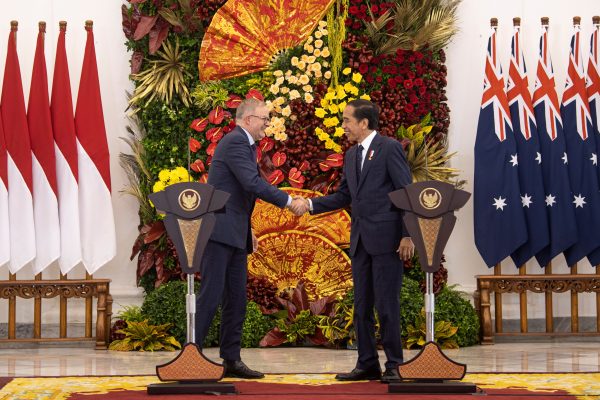Yet this is a partial reading of a longer history from the era of high imperialism to the Cold War when Australia had been an important — if reluctant — ordering power in Asia. A full accounting of Australia’s involvement from the Colombo Plan to the Southeast Asian Treaty Organisation and the Asian and Pacific Council challenges our received wisdom about the Cold War as a period of failed Asian regionalism.
We need to better understand this contentious past if we are to recover alternative alignments foreclosed by the global Cold War. One of the most important proposals from the archive of Asian internationalism centre on plans for a Japan–Indonesia–Australia trilateral framework. In 1972, Japanese and Indonesian diplomats and politicians opened discussions on a new cooperative framework among the three countries in the lead up to former Indonesian president Suharto’s visit to Japan the same year.
In the eyes of the Indonesian New Order government, the proposed Tokyo–Jakarta–Canberra axis had two major aims. It sought to align Jakarta and Canberra in restraining Japanese rapprochement with the People’s Republic of China. And with enunciation of the Nixon doctrine, Suharto believed the three countries shared key interests in limiting the PRC’s influence in Southeast Asia. But the proposal was rebuffed by Tokyo and Canberra which viewed the trilateral framework as a complication to diplomatic normalisation with the PRC.
More than 50 years later, the logic of a Tokyo–Jakarta–Canberra axis — shorn of the ideological inflexion of its anti-PRC posture — looks very different. Of course, one should not underestimate the formidable barriers to such an Asian alignment. Two members are bound by security treaties with the United States and the other is a leading member of ASEAN and an adherent of nonalignment in world politics.
The domestic and international context has also changed dramatically. Now it is expanding Sino–Indonesian diplomatic and economic ties that are blunting the impulse toward a new minilateralism. Yet old and new commitments do not necessarily constrain the political universe states inhabit. No state is a prisoner of time.
Despite the differences in political, historical and cultural geographies, there are clear precedents for a Tokyo–Jakarta–Canberra alignment grounded in decades of shared struggles for economic modernisation in a decolonised Asia. Led at the prime ministerial or cabinet level, the logic of triangular diplomatic coordination is compelling. The three powers represent a combined population of over 400 million and wield influential voices in key institutions of global governance, most prominently the G20. In traditional balance of power terms, this trilateral straddles three strategic environments — East Asia, Southeast Asia and the Pacific — making them key to any alteration of Asia’s geopolitical constellation.
A Tokyo–Jakarta–Canberra framework has the potential to generate new answers to Australia’s isolation in Asian multilateral organisations. A regionalism both autonomous and compatible with the US alliance poses many advantages. For Canberra, a new compact with Tokyo and Jakarta could simultaneously bolster collaboration between Australia and ASEAN and reinvigorate Indonesian leadership in Southeast Asia.
More broadly, this new alignment could legitimate Canberra as a more independent actor among new centres of power in the global south. Southeast Asia, to borrow a phrase from Allan Gyngell, might well serve as a ‘testing ground’ for international order.
The combined economic heft of a Tokyo–Jakarta–Canberra trilateral represents a powerful voice of opposition to the weaponisation of economic interdependence and US-led technological restrictions that have disrupted flows of globalisation. Halting the growing view of national and economic competition in zero-sum terms is a core interest of all three powers. The intersection of strategic and economic interests provides a ready-made agenda for security coordination on high technology, energy markets, food security and supply chains.
A Tokyo–Jakarta–Canberra trilateral also offers a new forum to manage an emerging multipolar regional order. There is a long prehistory to this effort. In the 1990s and 2000s, Japan, Indonesia and Australia were leading champions of the Asia-Pacific Economic Cooperation forum which was seen as a key institution to transcend divisions left by decolonisation, Cold War security pacts and military alliances.
Yet efforts to build a shared Asian future have been replaced by a region hardening into rival political and economic spheres and the reappearance of nonalignment as a major feature of international politics, now stripped of its idealism and grounded on a transactional realpolitik. Neither Japan, Indonesia or Australia has any interest in the tearing up of the post-1945 structures and a return, or more accurately, the inauguration of a new era of unvarnished power politics.
For Australia, the Tokyo–Jakarta–Canberra alignment requires the recovery of older visions of Asian regionalism alongside new modes of thinking about the past, present and future. Most importantly, this framework does not contradict Australian commitments to its technological and military alliance with the United States, still Canberra’s most consequential ally. Nor does it stand in the way of each power deepening their strategic relationship with India or the PRC.
The clarity and certainty which flow from Australian support for US primacy must once more be weighed against the necessity for Australia to recover its historical role at the centre of Asian regionalism.
Andrew Levidis is Lecturer and Research Fellow in modern Japanese history at the Australia–Japan Research Centre, Australian National University.

